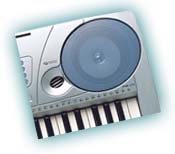|
You are the only person that can decide whether you like the
sound of a particular portable keyboard. What's the best way to
find out? Come on in to Allegro Music, turn on a portable
keyboard, hit the DEMO button and listen to the
built-in songs that are designed to show off the
sound of that keyboard. We know that you will be pleasantly
surprised. It's All About Samples
Keyboards use digital sampling technology, the same
method used on music CDs. To get a
grand piano sound, for example, the sound
from a real grand piano is recorded digitally, and this
digital recording (also known as a sample) is
stored in the keyboard's computer memory. Each time you
play a note, the keyboard replays the recording. The
quality of the sound depends upon the type of grand
piano recorded and the recording technology used. The
same digital sampling technology applies to all the
instrument voices on the keyboard.
But don't think that the entry-level models must
have a low-quality sound just because they're less
expensive. These days sampling technology is so good
that even on a low-priced keyboard, many people can't
tell the sampled instrument sound from the real thing.
The Speakers
 All portable keyboards are completely self-contained
with built-in amplifier and speaker (mono) or speakers
(stereo). Just turn on your
keyboard and play those keys! Though quality and
power (loudness) of the speakers is
usually governed by price, this is another feature you
need to hear for yourself. Even a
low-powered (low Watts) pair of speakers can provide
excellent sound quality and adequate volume. Some models
even include a special port on each speaker for extra
bass boost. All portable keyboards are completely self-contained
with built-in amplifier and speaker (mono) or speakers
(stereo). Just turn on your
keyboard and play those keys! Though quality and
power (loudness) of the speakers is
usually governed by price, this is another feature you
need to hear for yourself. Even a
low-powered (low Watts) pair of speakers can provide
excellent sound quality and adequate volume. Some models
even include a special port on each speaker for extra
bass boost.
Connection to Your Home Stereo
If you want some extra "oomph," portable keyboards have an output to
connect to
your home stereo system. You can also connect to professional audio
speakers for special performances with a band, choir or
string orchestra. All portable keyboards include a headphone jack so
you can practice with speakers off.
Polyphony
The
more the better! A keyboard's polyphony is the number of
notes it can produce at the same time. For instance, if
you play a 3-note chord with a 1-note melody, you need a
keyboard capable of at least 4-note polyphony. You might
think that 10-note polyphony is the most you need
because you have 10 fingers, but most of today's
portable keyboards have 16-note to 128-note polyphony.
Why? Because the keyboard must be able to sustain notes
as others continue to be played. With too little
polyphony, you can hear existing notes being cut off as
the keyboard "steals" them to play the new notes you
finger. So if you want to play advanced piano, chords
along with complex backing tracks, or layered sounds,
look for a keyboard with a 32-, 64- or even 128-note
polyphony.
Muti-Timrel
How many different instrument voices can the keyboard
play simultaneously? Most keyboards offer 16-part multi-timbrel.
Get it? It can play 16 different voices at once, which
is plenty for all but pro users.
|
